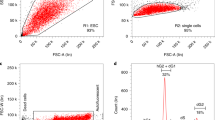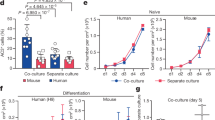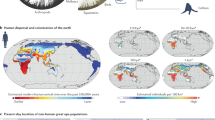Abstract
Cell fusions have a long history of supporting biomedical research. These experimental models, historically referred to as ‘somatic cell hybrids’, involve combining the plasma membranes of two cells and merging their nuclei within a single cytoplasm. Cell fusion studies involving human and chimpanzee pluripotent stem cells, rather than somatic cells, highlight the need for responsible communication and a revised nomenclature. Applying the terms ‘hybrid’ and ‘parental’ to the fused and source cell lines, respectively, evokes reproductive relationships that do not exist between humans and other species. These misnomers become more salient in the context of fused pluripotent stem cells derived from different but closely related species. Here, we propose a precise, versatile and generalizable framework to describe these fused cell lines. We recommend the term ‘composite cell line’, to distinguish cell lines that are experimentally created through fusions from both reproductive hybrids and natural cell fusion events without obscuring the model in overly technical terms. For scientific audiences, we further recommend technical nomenclature that describes the contributing species, ploidy and cell type.
This is a preview of subscription content, access via your institution
Access options
Access Nature and 54 other Nature Portfolio journals
Get Nature+, our best-value online-access subscription
$29.99 / 30 days
cancel any time
Subscribe to this journal
Receive 12 print issues and online access
$189.00 per year
only $15.75 per issue
Buy this article
- Purchase on Springer Link
- Instant access to full article PDF
Prices may be subject to local taxes which are calculated during checkout


Similar content being viewed by others
References
Ephrussi, B. & Weiss, M. C. Interspecific hybridization of somatic cells. Proc. Natl Acad. Sci. USA 53, 1040–1042 (1965).
Harris, H., Watkins, J. F., Campbell, G. L., Evans, E. P. & Ford, C. E. Mitosis in hybrid cells derived from mouse and man. Nature 207, 606–608 (1965).
Hyun, I. et al. Ethical standards for human-to-animal chimera experiments in stem cell research. Cell Stem Cell 1, 159–163 (2007).
Greely, H. T., Cho, M. K., Hogle, L. F. & Satz, D. M. Thinking about the human neuron mouse. Am. J. Bioeth. 7, 27–40 (2007).
Matthews, K. R. W., Wagner, D. S. & Warmflash, A. Stem cell-based models of embryos: the need for improved naming conventions. Stem Cell Rep. 16, 1014–1020 (2021).
National Academies of Sciences, Engineering, and Medicine; Policy and Global Affairs; Committee on Science, Technology, and Law; and Committee on Ethical, Legal, and Regulatory Issues Associated with Neural Chimeras and Organoids. The Emerging Field of Human Neural Organoids, Transplants, and Chimeras: Science, Ethics, and Governance (National Academies Press, 2021). These guidelines carefully consider stem cell biology approaches that risk blurring species boundaries.
Robert, J. S. & Baylis, F. Crossing species boundaries. Am. J. Bioeth. 3, 1–13 (2003).
Barski, G., Sorieul, S. & Cornefert, F. Production of cells of a “hybrid” nature in culturs in vitro of 2 cellular strains in combination [French]. C. R. Hebd. Seances Acad. Sci. 251, 1825–1827 (1960).
Creagan, R. P. & Ruddle, F. H. The clone panel: a systematic approach to gene mapping using interspecific somatic cell hybrids. Cytogenet. Cell Genet. 14, 282–286 (1975).
Nabholz, M., Miggiano, V. & Bodmer, W. Genetic analysis with human–mouse somatic cell hybrids. Nature 223, 358–363 (1969).
Köhler, G. & Milstein, C. Continuous cultures of fused cells secreting antibody of predefined specificity. Nature 256, 495–497 (1975).
Parray, H. A. et al. Hybridoma technology a versatile method for isolation of monoclonal antibodies, its applicability across species, limitations, advancement and future perspectives. Int. Immunopharmacol. 85, 106639 (2020).
Blau, H. M., Chiu, C. P. & Webster, C. Cytoplasmic activation of human nuclear genes in stable heterocaryons. Cell 32, 1171–1180 (1983).
Baron, M. H. & Maniatis, T. Rapid reprogramming of globin gene expression in transient heterokaryons. Cell 46, 591–602 (1986).
Piccolo, F. M. et al. Using heterokaryons to understand pluripotency and reprogramming. Philos. Trans. R. Soc. Lond. B Biol. Sci. 366, 2260–2265 (2011).
Cowan, C. A., Atienza, J., Melton, D. A. & Eggan, K. Nuclear reprogramming of somatic cells after fusion with human embryonic stem cells. Science 309, 1369–1373 (2005).
Lee, J. H. et al. Systematic identification of cis-silenced genes by trans complementation. Hum. Mol. Genet. 18, 835–846 (2009).
Looney, T. J. et al. Systematic mapping of occluded genes by cell fusion reveals prevalence and stability of cis-mediated silencing in somatic cells. Genome Res. 24, 267–280 (2014).
Cáceres, J. F., Screaton, G. R. & Krainer, A. R. A specific subset of SR proteins shuttles continuously between the nucleus and the cytoplasm. Genes Dev. 12, 55–66 (1998).
Piñol-Roma, S. & Dreyfuss, G. Shuttling of pre-mRNA binding proteins between nucleus and cytoplasm. Nature 355, 730–732 (1992).
Ohnuki, M. & Takahashi, K. Present and future challenges of induced pluripotent stem cells. Philos. Trans. R. Soc. Lond. B Biol. Sci. 370, 20140367 (2015).
National Research Council; Division on Earth and Life Studies; Board on Life Sciences; Policy and Global Affairs; and Committee on Science, Engineering, and Public Policy. Scientific and Medical Aspects of Human Reproductive Cloning (National Academies Press, 2002).
NIH. NIH research involving introduction of human pluripotent cells into non-human vertebrate anima0l pre-gastrulation embryos: notice number NOT-OD-15-158. National Institutes of Health https://grants.nih.gov/grants/guide/notice-files/NOT-OD-15-158.html (2015).
Zhao, X.-Y. et al. iPS cells produce viable mice through tetraploid complementation. Nature 461, 86–90 (2009).
Boland, M. J. et al. Adult mice generated from induced pluripotent stem cells. Nature 461, 91–94 (2009).
Kang, L., Wang, J., Zhang, Y., Kou, Z. & Gao, S. iPS cells can support full-term development of tetraploid blastocyst-complemented embryos. Cell Stem Cell 5, 135–138 (2009).
Gafni, O. et al. Derivation of novel human ground state naive pluripotent stem cells. Nature 504, 282–286 (2013).
Wu, J. et al. Interspecies chimerism with mammalian pluripotent stem cells. Cell 168, 473–486.e15 (2017).
Tan, T. et al. Chimeric contribution of human extended pluripotent stem cells to monkey embryos ex vivo. Cell 184, 2020–2032.e14 (2021). This study demonstrates the potential of human pluripotent stem cells to contribute to organismal development in appreciable numbers.
Aach, J., Lunshof, J., Iyer, E. & Church, G. M. Correction: Addressing the ethical issues raised by synthetic human entities with embryo-like features. eLife 6, e27642 (2017).
Warmflash, A., Sorre, B., Etoc, F., Siggia, E. D. & Brivanlou, A. H. A method to recapitulate early embryonic spatial patterning in human embryonic stem cells. Nat. Methods 11, 847–854 (2014).
van den Brink, S. C. et al. Symmetry breaking, germ layer specification and axial organisation in aggregates of mouse embryonic stem cells. Development 141, 4231–4242 (2014).
Lovell-Badge, R. et al. ISSCR guidelines for stem cell research and clinical translation: the 2021 update. Stem Cell Rep. 16, 1398–1408 (2021).
McNamee, S. Human–animal hybrids and chimeras: what’s in a name? Eur. J. Bioeth. 6, 45–66 (2015). These guidelines define categories of research and oversight levels required for human stem cell research, including the need for a compelling scientific rationale for experiments involving chimeric organisms.
St John, J. & Lovell-Badge, R. Human–animal cytoplasmic hybrid embryos, mitochondria, and an energetic debate. Nat. Cell Biol. 9, 988–992 (2007). This essay explores public communication and opinion about human–animal cybrid, hybrid and chimera experiments, and examines the connection between that reporting and research policy, particularly in the United Kingdom.
Li, X. et al. Generation and application of mouse-rat allodiploid embryonic stem cells. Cell 164, 279–292 (2016).
Gokhman, D. et al. Human–chimpanzee fused cells reveal cis-regulatory divergence underlying skeletal evolution. Nat. Genet. 53, 467–476 (2021).
Agoglia, R. M. et al. Primate cell fusion disentangles gene regulatory divergence in neurodevelopment. Nature 592, 421–427 (2021). Together with Gokhman et al., this report extends cell fusions to human and chimpanzee pluripotent stem cells and highlights the need for a revised nomenclature.
Song, J. H. T. et al. Genetic studies of human–chimpanzee divergence using stem cell fusions. Proc. Natl Acad. Sci. USA 118, e2117557118 (2021).
Department of Health. Human Fertilisation and Embryology Act 2008: explanatory notes. Legislation.gov.uk https://www.legislation.gov.uk/ukpga/2008/22/notes (2008).
Matthews, K. R. & Moralí, D. National human embryo and embryoid research policies: a survey of 22 top research-intensive countries. Regen. Med. 15, 1905–1917 (2020).
Brownback, S. S.659 — Human Chimera Prohibition Act of 2005. Congress.gov https://www.congress.gov/109/bills/s659/BILLS-109s659is.pdf (2005).
Smith, C. H.R.3542 — Human-Animal Chimera Prohibition Act of 2021. Congress.gov https://www.congress.gov/bill/117th-congress/house-bill/3542 (2021).
Hyun, I., Bredenoord, A. L., Briscoe, J., Klipstein, S. & Tan, T. Human embryo research beyond the primitive streak. Science 371, 998–1000 (2021).
Svoboda, E. The next frontier for human embryo research. Nature 597, S15–S17 (2021).
Gallego Romero, I. et al. A panel of induced pluripotent stem cells from chimpanzees: a resource for comparative functional genomics. eLife 4, e07103 (2015). This report establishes a widely used panel of human and chimpanzee iPSCs enabling in vitro studies of recent evolutionary changes.
Storchova, Z. & Kuffer, C. The consequences of tetraploidy and aneuploidy. J. Cell Sci. 121, 3859–3866 (2008).
Nagy, A. et al. Embryonic stem cells alone are able to support fetal development in the mouse. Development 110, 815–821 (1990).
Horii, T. et al. p53 suppresses tetraploid development in mice. Sci. Rep. 5, 8907 (2015).
Wilmut, I., Schnieke, A. E., McWhir, J., Kind, A. J. & Campbell, K. H. Viable offspring derived from fetal and adult mammalian cells. Nature 385, 810–813 (1997).
Wilson, M. D. et al. Species-specific transcription in mice carrying human chromosome 21. Science 322, 434–438 (2008). This report establishes a framework for studying gene regulatory evolution using reproductive hybrids that has now been extended to composite cell lines.
Kazuki, Y. et al. A non-mosaic transchromosomic mouse model of Down syndrome carrying the long arm of human chromosome 21. eLife 9, e56223 (2020).
Wittkopp, P. J., Haerum, B. K. & Clark, A. G. Evolutionary changes in cis and trans gene regulation. Nature 430, 85–88 (2004). This report describes a rare example of viable reproductive hybrids between chimpanzees and bonobos.
Hill, M. S., Vande Zande, P. & Wittkopp, P. J. Molecular and evolutionary processes generating variation in gene expression. Nat. Rev. Genet. 22, 203–215 (2021).
Vervaecke, H. & Van Elsacker, L. Hybrids between common chimpanzees (Pan troglodytes) and pygmy chimpanzees (Pan paniscus) in captivity. Mammalia 56, 667–669 (1992).
Prado-Martinez, J. et al. Great ape genetic diversity and population history. Nature 499, 471–475 (2013).
Greilhuber, J., Dolezel, J., Lysák, M. A. & Bennett, M. D. The origin, evolution and proposed stabilization of the terms “genome size” and “C-value” to describe nuclear DNA contents. Ann. Bot. 95, 255–260 (2005).
Acknowledgements
N.K.S. is supported by the Weill Neurohub Fellowship. A.A.P. acknowledges funding from the National Institutes of Health (NIH) (DP2MH122400-01), the Schmidt Futures Foundation and the Shurl and Kay Curci Foundation and is a New York Stem Cell Foundation Robertson Investigator. The authors acknowledge C. Lowe, C. Dorsett and members of the Pollen laboratory for critical feedback and insights.
Author information
Authors and Affiliations
Contributions
The authors contributed equally to all aspects of the article.
Corresponding author
Ethics declarations
Competing interests
The authors declare no competing interests.
Additional information
Peer review information
Nature Reviews Genetics thanks the anonymous reviewer(s) for their contribution to the peer review of this work.
Publisher’s note
Springer Nature remains neutral with regard to jurisdictional claims in published maps and institutional affiliations.
Rights and permissions
About this article
Cite this article
Pavlovic, B.J., Fox, D., Schaefer, N.K. et al. Rethinking nomenclature for interspecies cell fusions. Nat Rev Genet 23, 315–320 (2022). https://doi.org/10.1038/s41576-021-00447-4
Accepted:
Published:
Issue Date:
DOI: https://doi.org/10.1038/s41576-021-00447-4
This article is cited by
-
Current advances in primate genomics: novel approaches for understanding evolution and disease
Nature Reviews Genetics (2023)
-
Human-specific genetics: new tools to explore the molecular and cellular basis of human evolution
Nature Reviews Genetics (2023)



